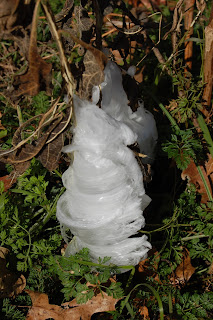We determined that each was coming from the broken stub of a woody stalk from a perennial plant that grew the previous season. We eventually learned that they were a perennial composite wildflower called Frostweed (Verbesina virginica). The next year we were able to establish them in our backyard. (I also learned not to allow the pretty white flowers to go to seed else all of my non-mowed areas will become a meadow of Frostweed).
 The stalks grow 5-7 feet tall and can attract butterflies and other insects. The Wildflowers of Arkansas book says that the leaves are eaten by deer. They grow along streams, roadsides, open slopes and valleys and bloom in late summer and fall.
The stalks grow 5-7 feet tall and can attract butterflies and other insects. The Wildflowers of Arkansas book says that the leaves are eaten by deer. They grow along streams, roadsides, open slopes and valleys and bloom in late summer and fall.The really cool thing is that in late fall or on certain days of winter--when the ground is well-saturated and unfrozen, but the nights are cold--the bottom of the frostweed stems will still actively pump water from the perennial roots up through the base of the stem. Since the above ground portion of the stem is dead wood and usually has broken off, the water has nowhere to go but out. The water hits the cold air and immediately turns to ice. The water pressure inside the plant continues to push it out in gorgeous ribbons of ice called "ice flowers" or "frost flowers". Each one is unique. The thin ribbons are adorned with minute striations or lines--like spun ice--when viewed up close, formed by ribs in the tissues at the base of the plant. By late morning they have all disappeared due to the warm sun. Their ephemeral beauty makes them all the more special.
I've seen this nondescript plant for years without giving it any special thought or knowing its name. Now I notice it all along the roadsides and bordering riparian areas (wooded corridors along creeks and rivers). I've seen the pretty ice flowers along Hwy 16 as I drive to work.
Here are some more photos of our frost flowers ...
Here's where I stripped the outer layer of lower stem to see where the "frost" is coming from:













